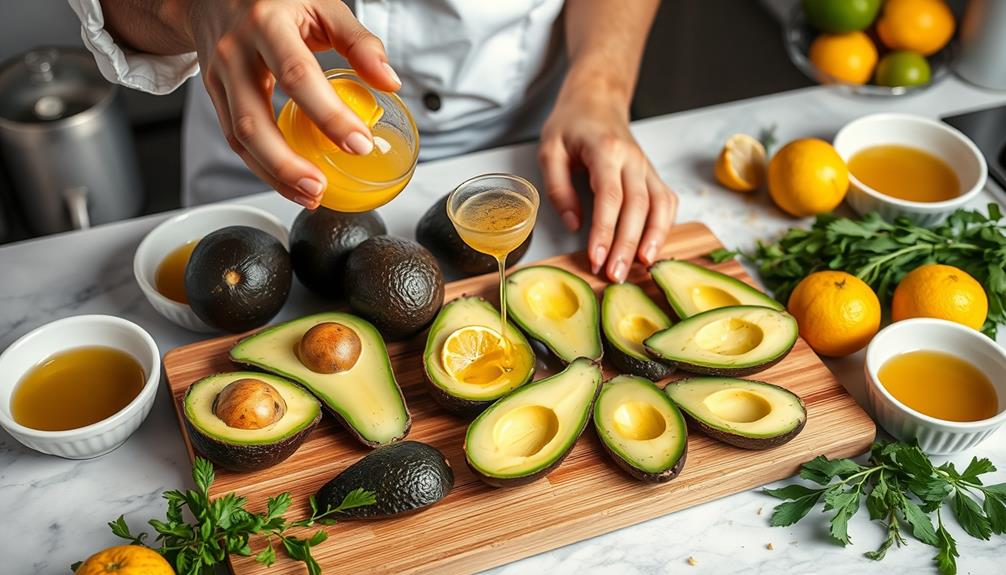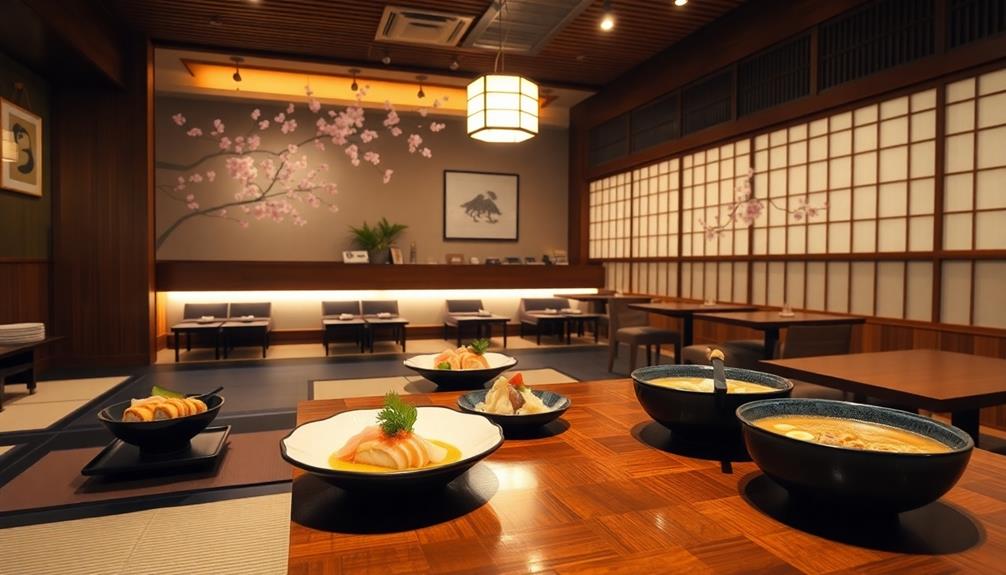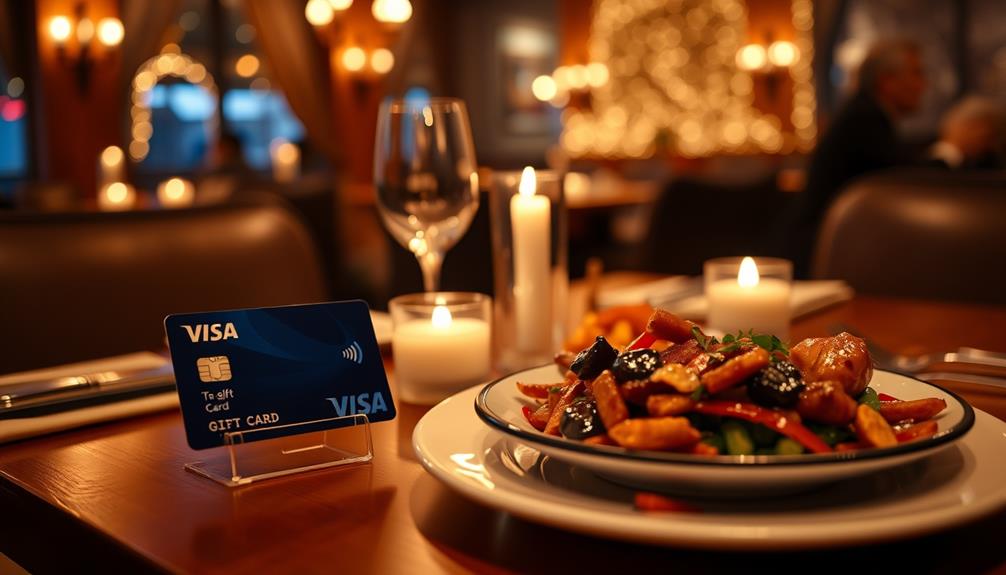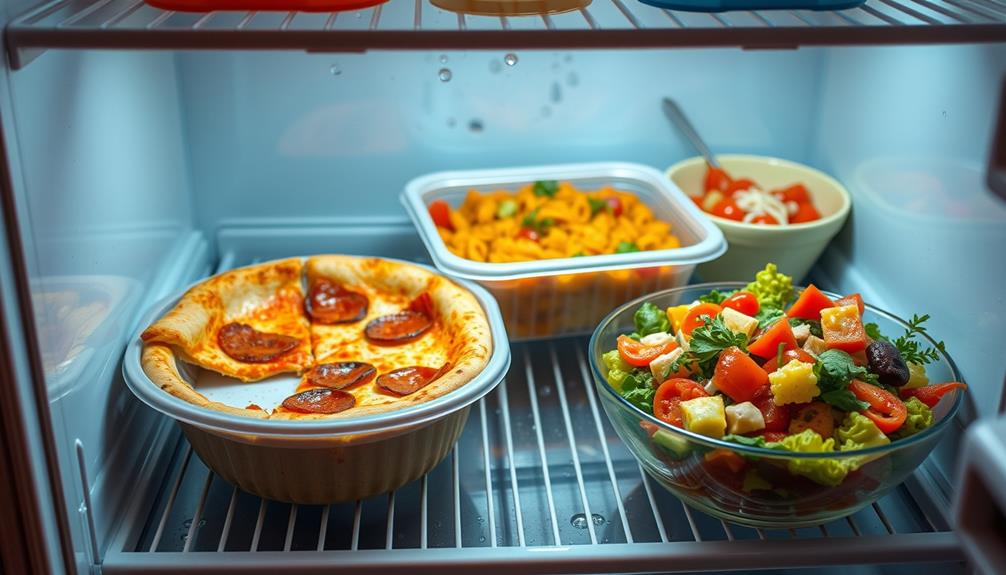Restaurants keep avocados from turning brown using a few smart methods. They often apply lemon or lime juice, which creates acidity and slows oxidation. Storing cut avocados in airtight containers minimizes air exposure, further reducing browning. Some places even keep the pits in halved avocados or store them with sliced onions, thanks to sulfur compounds that help maintain freshness. Cold water immersion also works wonders by limiting oxygen contact. These techniques not only keep the avocados looking fresh but also enhance their flavor. Keep exploring and you'll discover more tips on preserving the perfect avocado!
Key Takeaways
- Restaurants often apply citrus juice, like lemon or lime, to cut avocados to slow down the browning process through increased acidity.
- Storing cut avocados in airtight containers minimizes oxygen exposure, significantly extending their freshness and reducing browning.
- Keeping the avocado skin on until serving acts as a natural barrier against air, preserving the green color.
- Some establishments store cut avocados with sliced onions, leveraging sulfur compounds to help maintain freshness and reduce browning.
- Cling wrap is used tightly around cut avocados to limit air contact, which helps prevent oxidation and browning.
Reasons for Avocado Browning
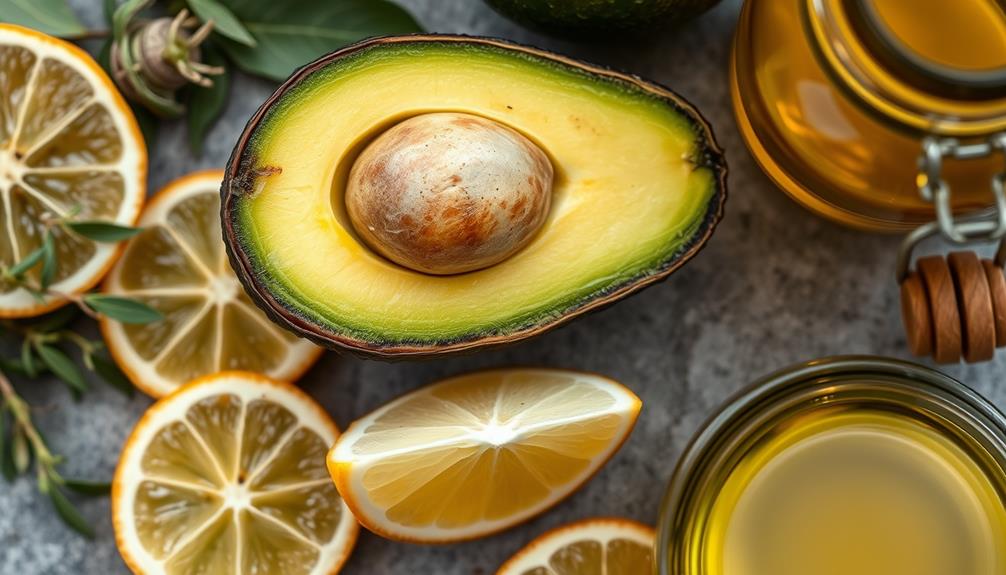
Avocados are a favorite ingredient for many, but their vibrant green color can quickly fade to an unappetizing brown. This browning occurs due to an enzyme called polyphenol oxidase, which reacts with oxygen when the avocado is cut or damaged. Once exposed, this enzyme triggers a chemical reaction known as enzymatic browning, making those beautiful green hues turn brown within hours.
To further complicate matters, cold medications can sometimes affect taste perception, making browning more noticeable. Damage to the avocado's skin can speed up this process, as the skin acts as a natural barrier against environmental stressors. If you don't consume the avocado right away, you might notice the brown color changing to a greyish-brown after some time. Although it's safe to eat, the taste may become bitter if you wait too long—typically around 9 to 12 hours.
Environmental factors like light and temperature also play a significant role in how quickly avocados brown. To prevent browning and keep avocados fresh, it's essential to store them properly. This means using airtight containers, wrapping them tightly, or even using citrus juice to create a protective layer.
Shelf Life of Avocados
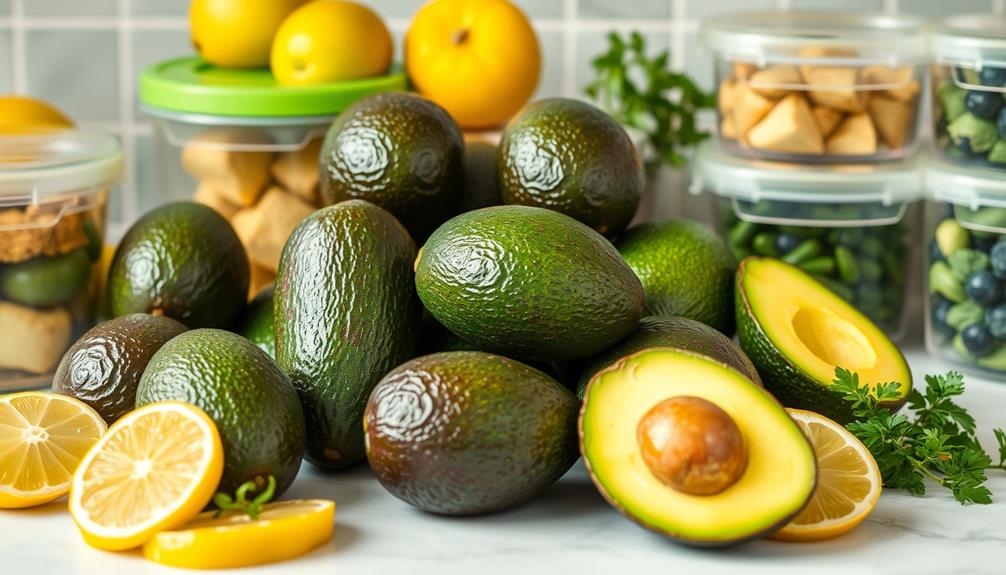
When it comes to the shelf life of avocados, understanding how to store them properly can make all the difference. Unripe avocados typically last 4-7 days at room temperature, while ripe avocados can stay fresh for 2-3 days when refrigerated. If you've cut avocados, their shelf life shortens considerably. They may start browning within hours at room temperature but can last 1-3 days in the fridge with the right storage techniques.
Here's a quick reference table to help you:
| Stage | Shelf Life (Room Temp) | Shelf Life (Refrigerator) |
|---|---|---|
| Unripe Avocados | 4-7 days | N/A |
| Ripe Avocados | N/A | 2-3 days |
| Cut Avocados | Hours | 1-3 days |
| Total Lifespan | N/A | Up to 10 days |
To keep avocados fresh, use airtight containers and consider adding lemon or lime juice to cut avocados. Even if they turn brown, they remain safe to eat, though their taste and texture may not be ideal. Proper storage helps extend the shelf life of avocados considerably.
Storage Methods for Cut Avocados
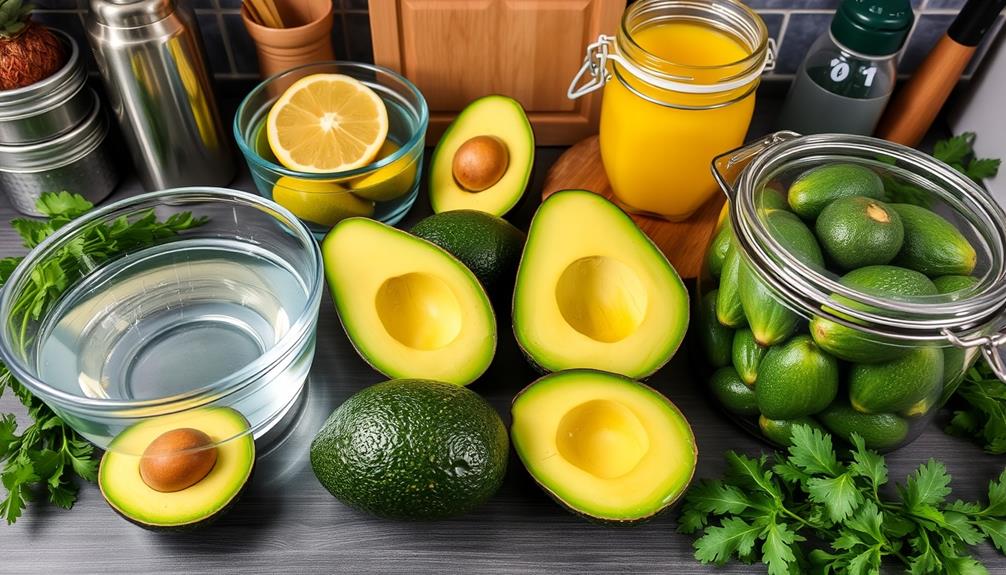
When it comes to storing cut avocados, using effective methods is key to keeping them fresh.
Incorporating natural remedies can also help preserve their quality; for instance, essential oils for health can provide additional benefits when used in conjunction with proper storage techniques.
You can extend their lifespan by placing them in airtight containers or adding a splash of lemon juice to slow down browning.
Effective Storage Techniques
To keep cut avocados fresh and visually appealing, restaurants employ several effective storage techniques. One popular method is using airtight containers. These containers minimize exposure to oxygen, which slows down the browning process. Additionally, you can add lemon juice or lime juice to your cut avocados. This acidic environment reduces browning by up to 50% due to ascorbic acid present in the juice.
Another technique involves leaving the skin on until you're ready to serve. The skin acts as a natural barrier against oxygen, considerably extending freshness. For short-term avocado storage, you might consider placing cut avocados in cold water, though this isn't ideal for longer durations.
Here's a quick summary of these techniques:
| Storage Technique | Description |
|---|---|
| Airtight Containers | Minimizes air exposure to reduce browning. |
| Lemon Juice | Creates acidity to slow down oxidation. |
| Plastic Wrap | Covers avocado flesh tightly to limit air contact. |
Importance of Freshness
Freshness plays an essential role in the dining experience, especially when it comes to cut avocados. These delicious fruits can brown within just a few hours at room temperature, so knowing how to store them properly is crucial for maintaining their quality.
When you refrigerate cut avocados, they typically last 1-3 days, but their flavor and texture can start to decline after just 24 hours. Understanding the importance of budgeting for quality ingredients can also enhance your culinary experience.
To keep your avocados fresh, consider these effective storage methods:
- Store cut avocados in an airtight container to minimize oxygen exposure.
- Add lemon or lime juice to the flesh; the acidity helps slow the browning process.
- Use cling wrap to create an oxygen barrier around the avocado.
- Place cut avocados alongside sliced onions, which can help preserve their freshness.
- Consider wrapping them tightly to prevent air from getting in.
Safety of Brown Avocados
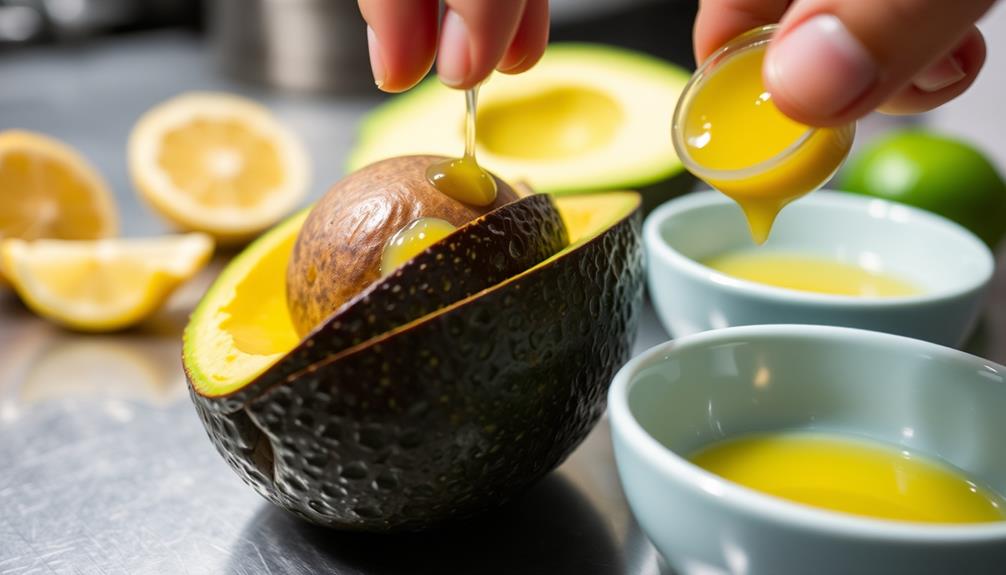
Many people worry about the safety of brown avocados, but there's good news: they're perfectly safe to eat. The browning you see is simply the result of a chemical reaction known as enzymatic browning. This process occurs when the flesh of the avocado is exposed to air, but it doesn't mean the fruit has spoiled.
It's important to remember that just like with breast cancer, early detection and understanding symptoms can help address concerns effectively, as outlined in the mammography guidelines.
While brown avocados may not look appealing, they remain edible for a few days after cutting. However, it's important to keep an eye on their quality. After about 9-12 hours of exposure to air, you might notice some bitterness and mushiness developing, which can affect the taste and texture.
Ripe avocados typically last 2-3 days in the fridge, but cut avocados spoil faster due to this increased exposure.
Restaurants often prioritize a fresh presentation, so they may choose to discard brown avocados for aesthetic reasons, even though they're safe to consume. This can lead to a significant amount of food waste, which can ultimately impact a restaurant’s bottom line. In fact, food waste is one of the common reasons for restaurant failure, as it can lead to increased costs and decreased profits. Additionally, discarding perfectly edible food can also contribute to environmental problems, such as greenhouse gas emissions from food decomposition in landfills.
Techniques for Preventing Browning
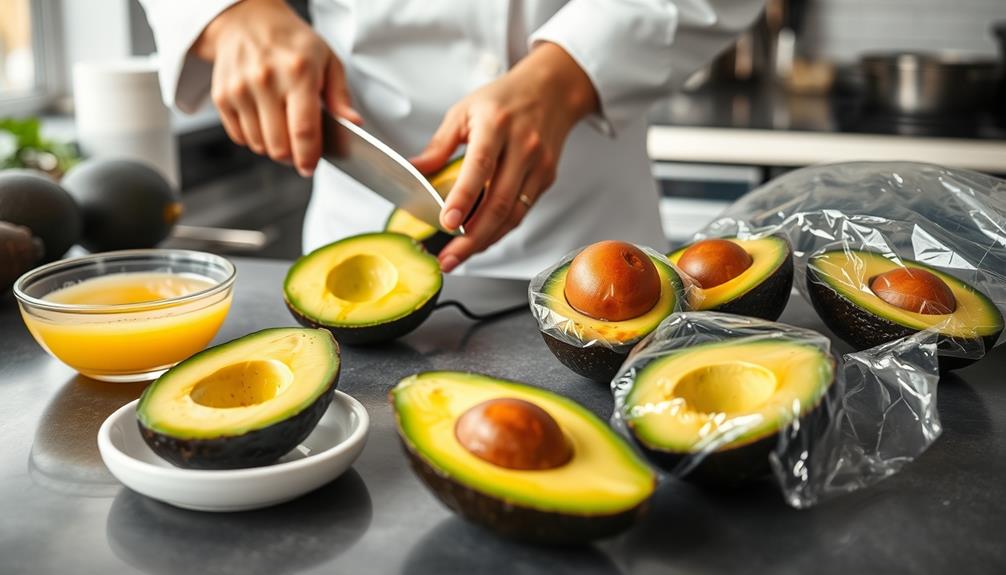
When it comes to preventing browning in cut avocados, several effective techniques can help maintain their vibrant green color. Using these methods, you can keep your avocados looking fresh and appetizing.
Additionally, just like butter enhances the texture of pastries and sauces, the right techniques can greatly improve the presentation of your avocados butter enhances texture.
- Lemon juice: Applying lemon or lime juice creates an acidic barrier, greatly slowing down oxidation.
- Onions: Storing cut avocados with sliced onions helps preserve freshness for up to two days due to sulfur compounds that counteract browning.
- Cold water immersion: Immersing your cut avocado in cold water minimizes air exposure, keeping them fresh and green for hours.
- Cling wrap: Wrapping your cut avocado tightly with cling wrap guarantees no air pockets are present, reducing oxygen exposure and browning.
- Pit method: While keeping the pit in a halved avocado offers minimal protection for the flesh it contacts, it's often combined with other methods for better results.
Proven Methods for Keeping Fresh
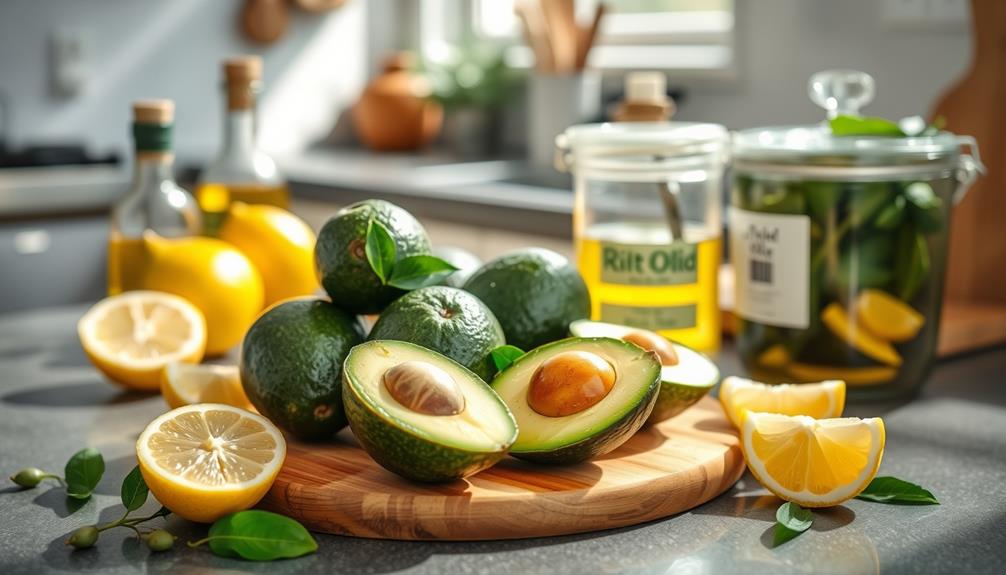
To keep your avocados fresh, using citrus juice is a game changer.
Applying lemon or lime juice not only adds flavor but also slows down browning by reducing oxidation, similar to how essential oils can enhance the properties of certain foods essential oils for skin conditions.
Pair that with airtight storage solutions, and you can extend their freshness considerably.
Citrus Juice Application
Citrus juice serves as a powerful ally in the battle against avocado browning. The acidity in lemon or lime juice greatly slows down the enzymatic browning process caused by polyphenol oxidase. By applying citrus juice, you can reduce browning by about 50%, making it a go-to method in culinary settings.
Plus, it adds a delightful flavor that complements dishes like salads and guacamole. Understanding the impact of various ingredients on freshness can enhance your culinary skills, especially when considering different brewing methods used in the coffee world.
Here are some proven tips for effectively using citrus juice:
- Apply juice immediately: Rub the cut side of the avocado with lemon or lime juice right after slicing.
- Use enough juice: Confirm the surface is well-coated for maximum effectiveness.
- Combine with onion slices: Pairing citrus juice with onion helps extend freshness.
- Store in airtight containers: Limit oxygen exposure to enhance the preservation of color.
- Reapply if needed: If the avocado is stored for longer, consider reapplying citrus juice before serving.
Airtight Storage Solutions
Airtight storage solutions are essential for preserving the freshness of cut avocados in restaurants. When you store cut avocados in airtight containers, you greatly limit their exposure to air, which slows down the browning process.
To boost this effect, consider combining airtight storage with lemon juice or lime juice. The acidity in these citrus juices helps inhibit oxidation, keeping your avocados looking fresh and appealing. Additionally, ensuring proper airflow around the storage unit can enhance the effectiveness of these methods, similar to how air purifier maintenance can improve overall air quality.
Another effective method involves placing sliced onions in the same airtight container as your cut avocados. The sulfur compounds released by the onions can extend the freshness of the avocados for about two days.
If you're looking for even more effectiveness, vacuum sealing techniques can be a game-changer in commercial kitchens. This method removes air from around the avocados, prolonging their freshness and preventing browning.
Properly sealing your cut avocados in airtight containers can keep them fresh for 1-3 days in the refrigerator. By implementing these airtight storage methods, you can maintain the quality of your avocados for service, ensuring your dishes look and taste their best.
Quick Ripening Techniques
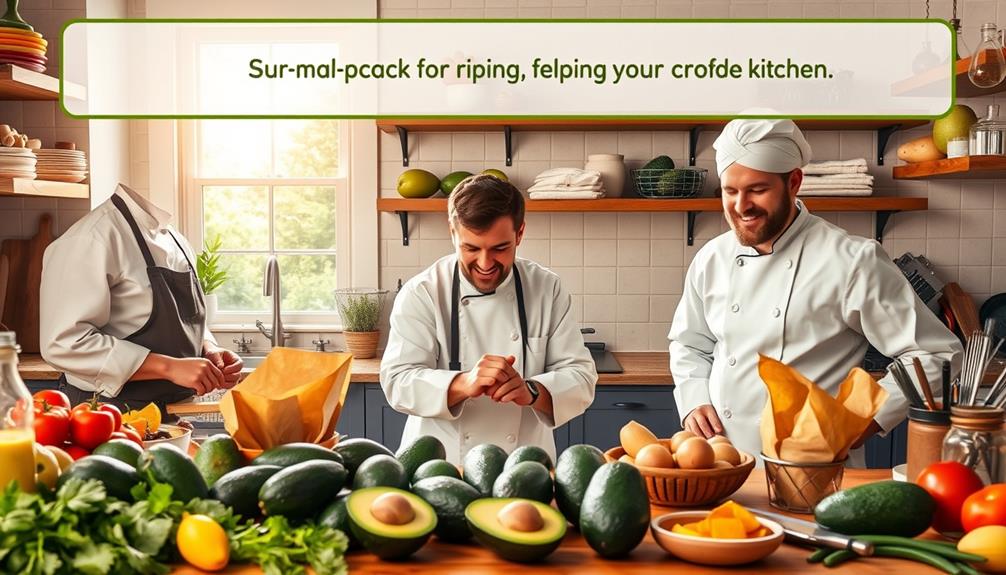
Releasing the perfect ripeness of avocados in record time can be achieved with a few simple techniques. If you've got unripe avocados and need them ready for service, consider these quick ripening techniques to speed up the process:
– Wrap in newspaper: This traps ethylene gas produced by the avocado, accelerating ripening.
Similar to how certain camping sites can benefit from unique camping experiences, the right environment can enhance the ripening process.
- Use paper bags: Place avocados in a paper bag in warm conditions; it enhances ripening within days.
- Pair with ethylene producers: Store unripe avocados alongside bananas or apples to leverage their ethylene emissions for faster ripening.
- Refrigerate ripe avocados: This helps slow further ripening, maximizing usability while preventing waste.
- Combine methods: Using a combination of these techniques can guarantee your avocados achieve the desired ripeness without compromising quality.
Nutritional Benefits of Avocados
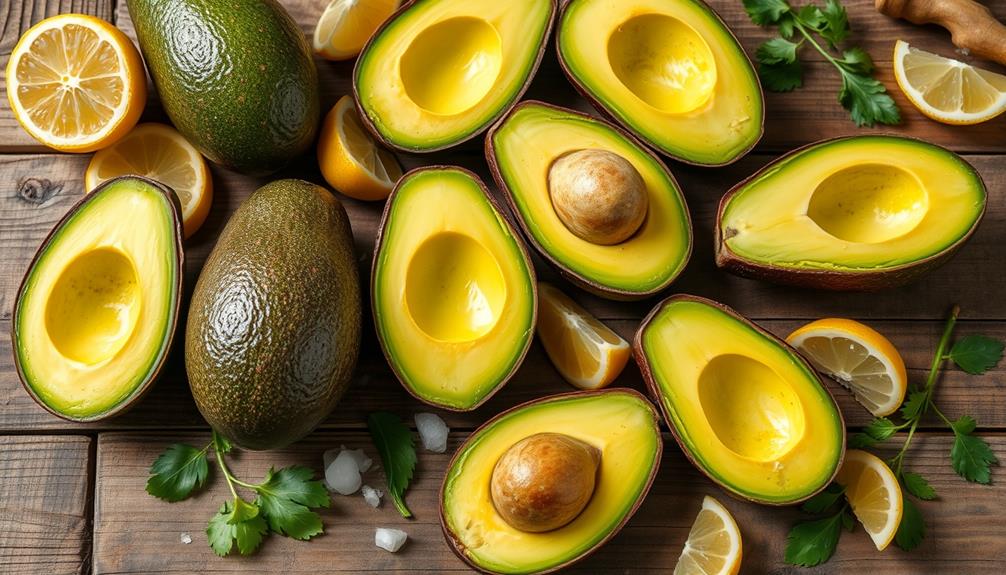
Once you've mastered the art of ripening avocados quickly, it's important to appreciate their impressive nutritional profile.
Avocados are packed with healthy monounsaturated fats that support heart health and may help lower bad cholesterol levels. This makes them a heart-smart addition to your diet. Additionally, avocados are rich in antioxidants, which are beneficial for overall health and may interact with certain medications.
They're also high in dietary fiber, which promotes digestive health and aids in weight management by enhancing satiety—helping you feel fuller longer. When it comes to vitamins, avocados shine as an excellent source of vitamins K, E, and C. Vitamin C, in particular, plays a significant role in immune function, skin health, and overall well-being.
Moreover, avocados provide a significant amount of potassium, essential for regulating blood pressure and maintaining proper muscle and nerve function.
Don't overlook the antioxidants found in avocados, such as lutein and zeaxanthin, which are beneficial for eye health and may reduce the risk of age-related macular degeneration.
Culinary Uses for Avocados
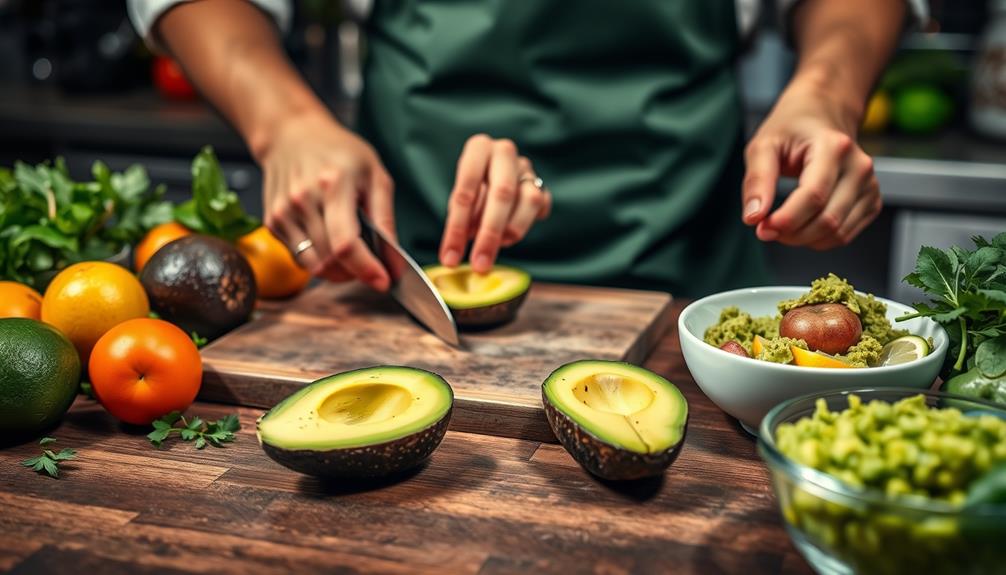
Avocados have earned their place as a culinary favorite thanks to their versatility and rich flavor. You can incorporate them in a variety of dishes, enhancing both taste and nutrition.
Here are some delicious culinary uses for avocados:
- Smoothies: Blend them in for creaminess and a boost of healthy fats and fiber.
- Spreads: Use mashed avocados on toast or sandwiches, pairing with toppings like tomatoes or eggs.
- Guacamole: Mash avocados for guacamole, customizing with garlic, lime juice, and herbs for unique flavor profiles.
- Salads: Add sliced or diced avocados to salads for a nutritious texture packed with vitamins and minerals.
- Soups: Blend avocados into soups, creating a velvety consistency while keeping the dish healthy.
To keep an avocado fresh, ascorbic acid can help slow down browning when you slice it.
With these culinary uses for avocados, you can enjoy their rich flavor and health benefits in countless ways. So, whether you're whipping up a smoothie or crafting a gourmet salad, avocados are sure to elevate your dishes.
Frequently Asked Questions
How Do Mexican Restaurants Keep Guacamole From Turning Brown?
Mexican restaurants keep guacamole vibrant by using lime juice for acidity, storing it in airtight containers, and covering it with plastic wrap. They also prepare it fresh daily, limiting exposure to air and preventing browning.
How Do You Stop an Avocado From Going Brown?
To stop an avocado from going brown, you can squeeze lemon or lime juice on it, store it in an airtight container, or keep the pit in. These methods help preserve its freshness effectively.
Does Lemon Juice Stop Avocados From Browning?
Yes, lemon juice does stop avocados from browning. It contains ascorbic acid, which inhibits the enzyme responsible for browning. Just rub the cut side with lemon juice right after slicing for best results.
How Do Restaurants Preserve Avocados?
You might think preserving avocados is tough, but it isn't! Restaurants often use lemon juice, airtight containers, or cold water immersion to keep avocados fresh and green, ensuring they look great on your plate.
Conclusion
To savor the splendid, creamy goodness of avocados without the dreaded browning, remember these practical pointers. Choosing clever storage solutions, using citrusy companions, or opting for airtight containers can keep your avocados vibrant and appealing. So, whether you're whipping up a zesty guacamole or topping your toast, keep these techniques in mind. With a little care, you'll enjoy the luscious, lovely taste of avocados, bright and beautiful, every single time!
